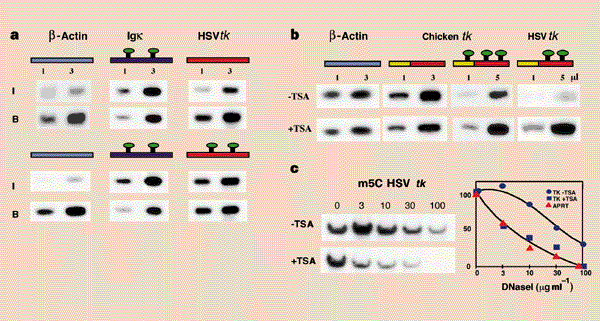DNA methylation models histone acetylation (original) (raw)
Immunoprecipitation was used to isolate specifically the highly acetylated mononucleosome fraction1 from stably transfected cells carrying either methylated or unmethylated copies of the thymidine kinase gene (tk) from herpes simplex virus (HSV). This technique clearly separates the transcriptionally active acetylated nucleosome fraction from bulk chromatin. The constitutively expressed β-actin gene, for example, is enriched in the acetylated fraction (4.5-fold), as are exogenous copies of the unmethylated tk gene (also 4.5-fold). In contrast, methylated tk sequences behave like endogenous inactive genes (for example, the Igκ gene), and are not preferentially associated with acetylated histones (Fig. 1a). Because identical DNA sequences were used in both transfection experiments, this decreased level of chromatin acetylation must be due to the presence of 5-methyl cytosine. These experiments therefore demonstrate that DNA methylation influences local histone acetylation, and it has now been shown that the methyl-binding protein MeCP2 is probably involved in this process by recruiting histone deacetylases3,4.
Figure 1: DNA methylation, histone acetylation and chromatin structure.
a, Micrococcal nuclease-prepared mononucleosomes from pools of L-cell colonies stably transfected with unmethylated (upper portion) or in vitro SssI-methylated (lower portion) HSV tk were precipitated with antibodies mainly specific to acetylated histone H4 (ref. 1). DNA was extracted from input (I) and bound (B) fractions and subject to quantitative polymerase chain reaction (PCR) using primers for HSV tk and mouse β-actin or Igκ. Two concentrations (1- and 3-fold) are shown. The degree of enrichment was determined by phosporimager or gel scan analysis. Methylated HSV tk is present in higher average copy number than the unmethylated vector. Green blobs indicate DNA methylation. b, Cells were stably transfected with unmethylated or in vitro SssI-methylated chicken tk gene or the hybrid HSV tk gene6 methylated in the coding region (red) but not the promoter (yellow). Quantitative PCR conditions were established empirically for each gene and cell type, and carried out on two concentrations (1- and 3-fold, or 1- and 5-fold) of equivalent amounts of cDNA from untreated or TSA-treated (50 ng ml−1, 24 h) cells. The β-actin results are from one of the cell lines. c, Nuclei from a mixture of cells containing either the fully methylated HSV tk or the unmethylated hamster aprt gene (± TSA) were digested with increasing concentrations of DNaseI and the DNA was extracted and subject to blot hybridization analysis8. The graph (based on phosphorimaging of the blots) shows tk sensitivity to DNaseI (percentage of total DNA) as compared with aprt (average of ±TSA samples, which were very similar) on the same blot.
We investigated whether this under-acetylation contributes to transcriptional inhibition. We used the drug trichostatin A (TSA) to increase general histone acetylation in the cell5 in an attempt to bypass the inhibitory effects of DNA methylation (Fig. 1b). Treatment with TSA resulted in a 2.5-fold increase in transcription from a fully methylated chicken tk gene. This stimulation was the resulted of a specific release from methyl-induced repression, rather than a boost in gene expression, as transcription from both the endogenous β-actin and the exogenous unmethylated chicken tk genes was unaffected by TSA treatment. Maximal induction by TSA (7-fold) was obtained on an HSV tk gene methylated exclusively in non-promoter regions6. Most DNA methyl sites in the genome are not located within regulatory elements. Thus, histone deacetylation may be an important mediator of the global repression associated with DNA methylation.
It has been shown that the presence of methyl groups on exogenously introduced sequences makes local chromatin structure less accessible to the transcription machinery7 and molecular probes, such as DNaseI8. To determine whether this inactive chromatin structure is brought about by histone deacetylation, cells carrying fully methylated copies of the HSV tk gene were treated with TSA. Although remaining fully methylated (data not shown), these sequences are converted to a DNaseI-sensitive conformation (Fig. 1c), indicating that histone deacetylation itself is a critical factor in the generation of DNaseI-insensitive structures associated with methylated DNA.
The mammalian genome has a bimodal methylation pattern in which CpG islands in housekeeping genes are constitutively unmodified, whereas most tissue-specific genes are generally methylated in every cell type except those that actually express the gene9. This profile is established through a series of de novo and demethylation events, and is perpetuated by maintenance methylation through subsequent cell divisions10. We propose that this pattern helps to set up local histone acetylation states. After replication, newly deposited histones in unmethylated regions may undergo acetylation, but nucleosomes containing methylated DNA will be subject to deacetylation throughout the cell cycle.
Histone acetylation is a fundamental regulatory mechanism for controlling gene accessibility, and it is therefore not surprising that the cell uses a variety of different molecular pathways for its modulation. Our results indicate that in higher organisms DNA methylation may serve as a unique mechanism for setting up local histone deacetylation, and so generate maintainable epigenetic chromosomal states.
